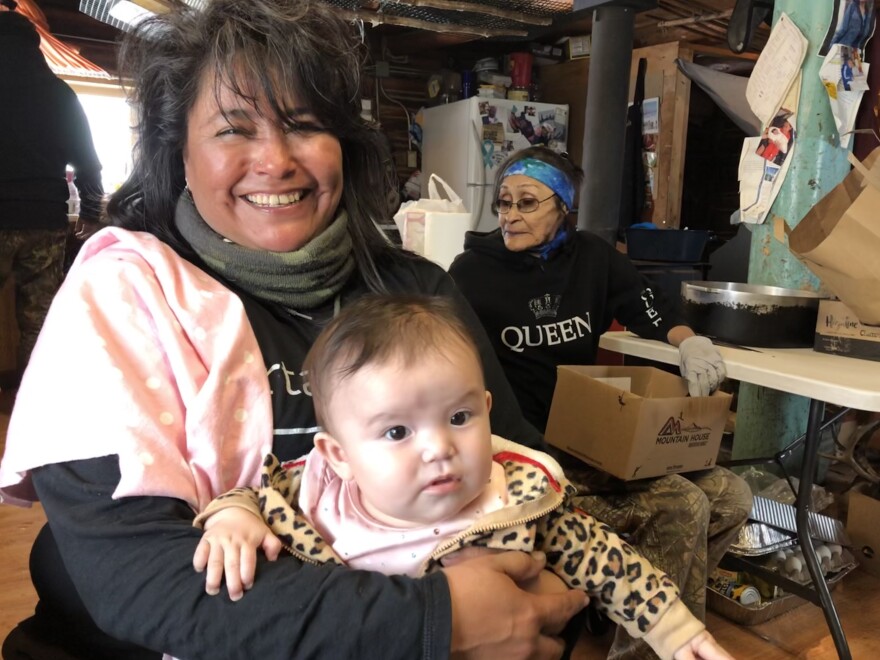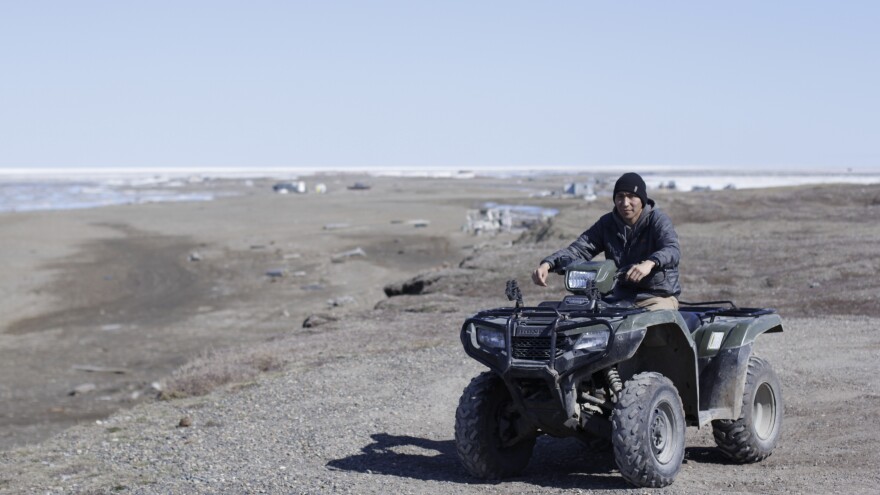David Smith Jr. opposes oil drilling in the Arctic National Wildlife Refuge. He's worried about harm that could come to the Porcupine caribou herd.
Nathan Gordon Jr., says development can be done responsibly, and that drilling and caribou can, and do, co-exist on the North Slope.
These are decades old arguments often heard in Washington, D.C., but they've moved from hypothetical to urgent since Congress legalized oil development in the northern slice of the refuge in 2017. The Trump administration is pushing to let oil companies bid on land there by the end of the year.
And for Smith and Gordon, that drilling would happen, essentially, in their backyard.
Smith lives in Arctic Village, an indigenous Gwich'in community of about 150 just south of the refuge. Residents say the caribou herd that often gives birth in the refuge is essential to their way of life.
Gordon is from Kaktovik, an Inupiat town of 250 and the only village surrounded by the coastal area where drilling could take place. Residents have already benefited from oil development elsewhere on the North Slope and some see more drilling as an opportunity.

"Proud to be caribou people"
Arctic Village has long been the face of opposition to drilling in the Arctic National Wildlife Refuge, often called ANWR, and no one is ready to admit defeat.
An annual carnival in April showed the central place the herd plays in people's diet and culture. Men gathered around plastic folding tables for a caribou leg skinning contest. Their knives worked from knee to cloven hoof, hands tugging hide and meat from bone.
One of the top finishers was Smith, 22. He is a village leader — the second chief — and like many here, he thinks oil development in the refuge threatens the Porcupine caribou herd his people hunt.
"If they do drill, that's going to change the migratory path of the caribou," Smith says. "And that's going to change our very lifestyle. The reason we're here is for the caribou."
Today, roughly 200,000 caribou migrate past Arctic Village and other Gwich'in communities every year.
"I would say this is like no other place on earth, so we shouldn't be treated like any other place on earth," Smith says. "I can drive in any direction and hunt freely. I can drive in any direction and go trapping."
The Porcupine caribou herd commonly gives birth in the same 1.6 million-acre part of the refuge where drilling is now legal, known as the coastal plain. Scientists say predicting exactly how oil development will affect the herd's population or migration patterns is tricky.
In other parts of Alaska's Arctic, calving caribou were able to shift their movements away from oil infrastructure and still access similar habitats. But the calving area in the refuge is narrower, hemmed in by a mountain range and the Arctic Ocean, so some biologists worry the impacts will be greater.
Arctic Village tribal council member Faith Gemmill says when Congress legalized drilling in the refuge, it shifted the ground beneath the Gwich'in, but also galvanized them.

"It's put our tribe in the position of defense, and we have to work harder than we've worked before to try to defeat that," Gemmill says.
And they have kept fighting every way they can. Gwich'in advocates have forged strong alliances with environmental groups, and they continue traveling to Washington, D.C., to lobby members of Congress. They know a lot could happen between now and when oil rigs show up in the refuge. Environmental groups could sue to slow down the process, and there's the U.S. presidential election.
"We're proud to be caribou people, we love our food," says village elder and longtime activist Sarah James. "We're never going to surrender."
Smith, Arctic Village's second tribal chief, agrees. "I believe everything is going to come out on top for us," he says.

A village built on oil
More than 100 miles north of Arctic Village, Kaktovik perches on an island in the Arctic Ocean.
It's the only community along a 200-mile stretch of Alaska's North Slope, but there's been some new visitors of late. Melting sea ice means more hungry polar bears coming to the village of 250. On a recent warm spring day, Nathan Gordon Jr., 24, kept watch from the seat of his four-wheeler.
"It's part of my job to make sure the town is safe, and all the visitors and the polar bears at the same time," he says.
The Arctic refuge's tundra and mountains surround Kaktovik. There are no roads in or out, and there's no oil infrastructure nearby.
But Gordon's paycheck? It comes largely from the oil industry, thanks to drilling in Prudhoe Bay to the west.
The industry pays some $370 million in annual property taxes to the North Slope Borough. That money helped pay for Kaktovik's $16 million new basketball gym. It funds a full-time fire department, with two gleaming fire trucks. Residents also have flush toilets, which are lacking in dozens of other Alaska villages outside the refuge.
Oil, Gordon says, has done a lot for Kaktovik and its Native Inupiat residents, and he supports drilling in the refuge.
"People have been benefiting really great through all of this," Gordon says. More oil development "would be great for our kids, for the economy, for our village."

Kaktovik's drilling boosters believe their opinions should hold more sway than opponents', since their ancestral lands are closer to where drilling would happen. And while their culture may not be as centered on caribou, surveys show each household here consumes hundreds of pounds of caribou a year, and as much as 1,000 pounds of bowhead whale.
"They think that we're trying to make it to where it's just going to be like a big oil field out there," says Charles Lampe, who captains a whale hunting crew. "That's not what we're trying to do."
Lampe thinks oil development could be done responsibly, avoiding areas where people hunt.
Gordon, a subsistence hunter, says he's also not worried about the effect of oil infrastructure on caribou populations. "It'll be a lot safer for them to be out there than being hunted by me," he says.
If development does harm the Porcupine caribou herd, whale meat would be a safety net for the residents of coastal Kaktovik. That's not the case in landlocked Arctic Village.
"If they wanted whale, we'd send them whale," Lampe says. "I mean, that's the kind of community and the kind of people we are."
Other Kaktovik residents are less convinced that oil infrastructure can coexist with their own traditions. A poll by the village government found 52 percent in favor of development, 32 percent opposing it, the rest unsure.
Carla Kayotuk, an avid hunter and camper who opposes drilling, says that even living in a small village she values the open spaces nearby.
"When we get away, it's quiet right now," she says. Once development starts, "Where are we going to go?"
Speaking up against development can be intimidating here, Kayotuk says. She's been accused of ignoring benefits from oil that could come to the village. "We're not ignorant," she says. "We just value something different."
It's still too early to know exactly how close oil infrastructure might come to Kaktovik. After a lease sale, companies will have to drill wells to see if commercially viable amounts of oil even exist under this coastal plain. If they find it, they'll need environmental reviews and permitting before they can pump it out.
From atop the bluff at the edge of town, Gordon, the polar bear patroller, looks out over the tundra to the west, where he thinks the first oil development is likely. What does he think he'll see on the horizon once that starts?
"Nothing," he says. "You won't be able to see a footprint out there."
Ravenna Koenig contributed to this story.
Copyright 2020 Alaska Public Media. To see more, visit Alaska Public Media.

